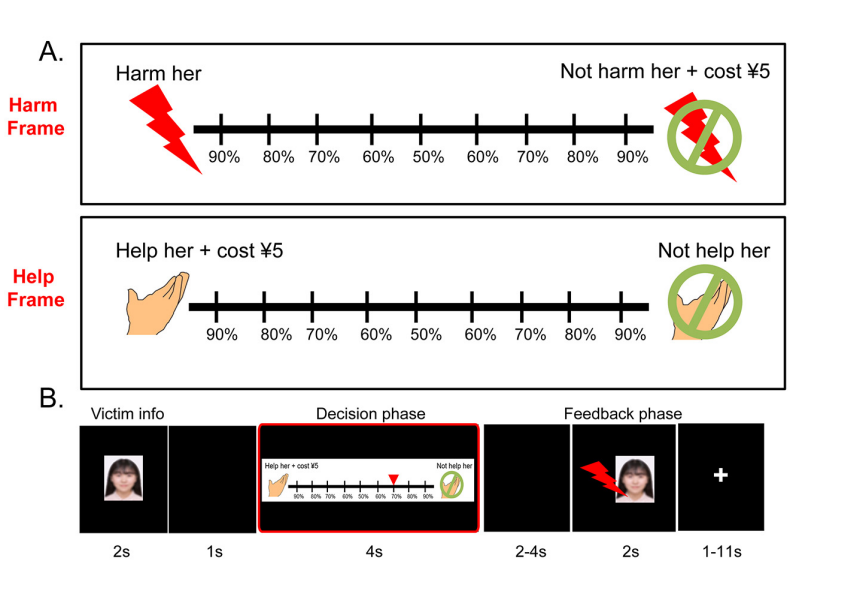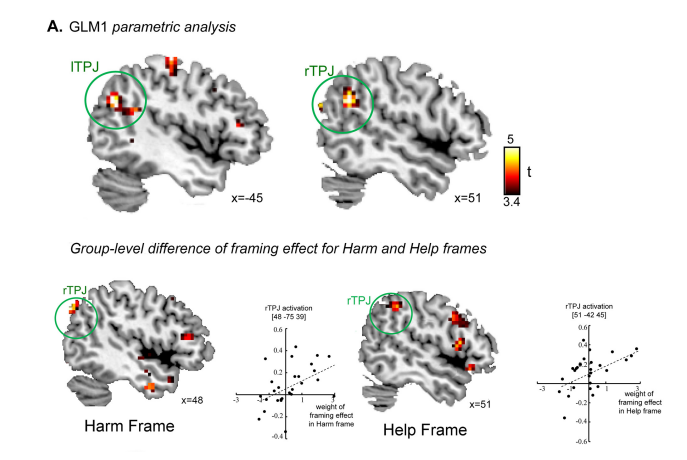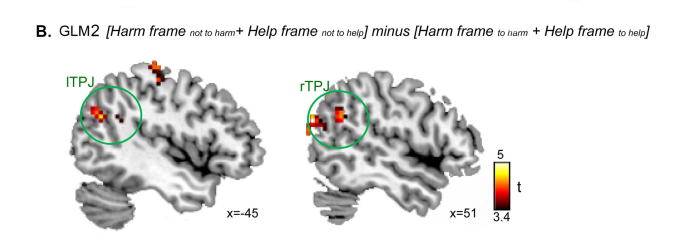The Neural Mechanism of Social Framing Effect: Verbal Expression Influences Altruistic Decision-Making
There was a miser who fell into a river. A kind man shouted from the bank, “Give me your hand and I’ll pull you up!” But the miser would not give him his hand. The kind man was confused, then suddenly realized and shouted to the sinking man again, “I’ll give you my hand. Hold me!” The miser immediately reached out and grabbed the kind man’s hand.
Framing effect, means that in decision making, the preference of different options could change in response to two objectively, but not verbally, equivalent statements if a problem is described in different ways. In a recent paper published in Journal of Neuroscience, which is the top journal in the field of international neuroscience, the Associate Professor Fang Cui and her research group explored the neural mechanism of how different ways of expression influence individuals’ altruistic decision-making, namely the social framing effect.
The social framing effect could be distinguished from the non-social one according to whether a social dilemma between the self and others is involved in the current scenario.
● When making non-social decisions, people focus on maximizing their individual utility, and decision frames affect their judgment of which option is more beneficial or less risky . In this case, the frame regulates their judgement of potential benefits and risks, such as the Gain/Loss framework.
● When making social decisions,people take the consequence of their actions to others into account, and decision frames affect people’s preference through the influence of other-regarding concerns and social norms such as fairness, altruism, and reciprocity.
Existing studies mainly focus on the non-social framing, most of which adopt the Gain/Loss paradigm. The results showed that the amygdala and anterior cingulate cortex (ACC) were two key brain regions in the non-social framing effect. Framing effect is related to individual anxiety traits (De Martino et al., 2006; Xu et al., 2013). The psychological mechanisms of the social framework are quite different from those of the non-social framework, so the neural mechanisms are likely to be different as well. Previous studies on framing effects considered little at social aspects.
In this study, the research group designed a novel task paradigm to stably induce social framing effect. The core logic comes from Crockett et al. (2014) 'Avoidance of causing pain to others is a powerful motivation for action' and thus creates an avoidance dilemma between one's own economic gain and the pain of others.
The participants were asked to make a tradeoff between economic benefits and the feelings of others. When participants showed stronger preference to income maximization, the probability for their partners to receive a painful electrical shock would increase proportionally. Paradigms consist of two frameworks:
● Harm frame: Choosing to maximize one's personal benefit while inflicting painful shocks on others is described as "actively harming others".
● Help frame: The option of maximizing personal gain while inflicting painful shocks on others is described as "not helping others".
It is worth noting that the decision maker is faced with essentially the same choice under both frameworks, which is whether to spend 5 yuan of his own money to save someone else from the shock. The only difference between the two frameworks is the way the results are described.

Fig. 1 Schematic diagram of experimental design(A)harm frame and help frame
(B)Trial process
At the behavioral level, this paradigm induces a significant social framing effect: Subjects under the "harm frame" show a stronger altruistic tendency than those under the "help frame". At the neural level, the intensity of framing effect was found to be related to the activation level of temporoparietal junction (TPJ), especially the right part. Machine learning analysis of brain activation patterns also found that the right TPJ was effective in differentiating between trials consistent with and inconsistent with the framing effect. In addition, the strength of functional connection between the right TPJ and the medial prefrontal lobe can also predict the strength of the social framing effect at the behavioral level.


Fig. 2 Results of fMRI experiment(A)Frame effect is correlated with bilateral TPJ activation intensity(B)Bilateral TPJ neural modes can predict the framing effect
To test the causal relationship between the right TPJ and the social framing effect, TDCS was used in Experiment 2 to modulate the cortical excitability of this brain region. The results showed that positive TDCS enhanced the social framing effect, but had no significant effect on the non-social framing effect (i.e., the GAIN/LOSS framework).
This study shows that, unlike the neural basis of non-social framing effect, the key brain region of social framing effect is TPJ, especially its right side. It is possibly related to the important role of this brain region in opinion selection and moral processing. The results can improve the understanding of social decision-making and also help to consider how to promote helping behaviors in daily life.
After the paper was published, it gained the attention of relevant research fields at home and abroad. “These findings are important because a deeper understanding of the differences between social and non-social decisions and how the brain processes them could increase understanding of how to enhance prosocial behavior”.
Journal of Neuroscience is included in JCR1 Region of the Chinese Academy of Sciences (upgraded edition in 2020). Assistant Professor Jie Liu in Center for Brain Diseases and Cognitive Neuroscience, Shenzhen University, and Professor Ruolei Gu in Key Laboratory of Behavioral Sciences, Institute of Psychology, Chinese Academy of Sciences, are co-first authors of this paper. Associate Professor Fang Cui, School of Psychology, Shenzhen University, is the corresponding author of this paper. Shenzhen University is the first communication unit. This work was supported by the National Natural Science Foundation of China (no. 31871109, 31571124, 31900779), the Youth Innovation Promotion Association CAS (no. 2019088), Shenzhen-Hong Kong Institute of Brain Science-Shenzhen Fundamental Research Institutions (no. 2019SHIBS0003), and the Major Program of the Chinese National Social Science Foundation (no. 17ZDA324).
Paper information:
Liu, J., Gu, R., Liao, C., Lu, J., Fang, Y., Xu, P., Luo, Y., Cui, F. (2020). The neural mechanism of the social framing effect: evidence from fMRI and tDCS studies. Journal of Neuroscience, 40 (18) 3646-3656. DOI: 10.1523/JNEUROSCI.1385-19.2020

 WeChat
WeChat